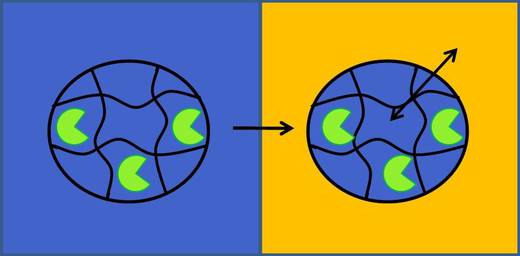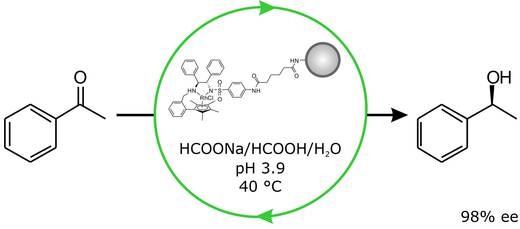C1 Process applications of catalysts
The reactivity of a catalyst depends on the combination of materials and on a number of technical parameters, in particular the morphology of the support, the fluid dynamics, and the contact times of the reactants. Support materials can either be hard or soft matter and have to be customised for each catalytic system. Hard matter systems are chosen from the wide range of ceramic materials, while soft matter systems are based on self-assembling amphiphiles and functional polymeric structures such as polyelectrolytes, dendritic polymers and polymer gels.
Research goals
Transfer of promising catalytically active materials synthesised in Research Area A into process-suitable catalysts.
Immobilisation of homogeneous chemocatalysts and biocatalysts by methods based on new polymeric materials that enable efficient catalyst recovery by phase transfer or membrane separation processes.
Development of a durable porous support with a highly specific surface and long-life activity for OCM catalysts by controlling the morphology of the support.
Results/Achievements
The progress obtained in this field is based on the synergies between expertises in catalysis and material science. The detailed knowledge of the material properties and the methods for their modification gave essential contributions to the substantial progress achieved with the investigated catalysts. Especially the understanding of heterogeneous catalysts benefited greatly from the close collaboration of group contributing with synthesis, testing and characterization before, during and after catalytic reactions.
- For enzymes and homogeneous catalyst for fine chemical and drug synthesis immobilization methods were developed in order to prepare more stable catalyst with a high live time and good recycleability, that allows repetitive utilization of the catalyst. A versatile method is provided for this purpose based on hydrogel microparticles that enable the transfer of hydrophilic nanoparticles and enzymes to organic media via stepwise solvent exchange.
- A catalyst for the asymmetric transfer hydrogenation of prochiral ketones was immobilized on polymer bead and shows for a broad substrate spectrum a remarkable activity and stability. This catalyst was developed in collaboration of two UniCat research groups and our industrial partner PolyAn and is already commercialized
- As a catalyst suitable for fundamental investigation performed in Research Field A1 as well as for engineering studies in Research Field C4 lithium doped magnesium oxide (Li/MgO) was selected. It was produced according to different published procedures and also from different precursors. As a result of a systematic study of the kinetics of the reaction an unusual strong variation in the catalytic performance of nominally the same catalysts was found. It is caused by the instability of the materials under the process conditions of OCM. Different precursor materials and test conditions result in different deactivation dynamics and therefore in very different test results during the first days of experimental studies.
- A catalyst is provided for engineering studies on laboratory and mini plant level from a screening of catalysts that was focused on the stability of the material under OCM conditions. Out of the literature known materials Na2WO4/Mn/SiO2 fulfils the requirements for a process suitable catalyst best. For detailed studied of the tungstate catalyst on different scales a preparation on the kilogram scale was developed using fluidized bed technology
Most important publications
Bridging the Materials Gap in Catalysis: Entrapment of Molecular Catalysts in Functional Supports and Beyond A. Thomas, M. Driess Angewandte Chemie International Edition 2009, 48, 1890 - 1892, 10.1002/anie.200805136
The Catalytic Activity of Zinc Oxides from Single Source Precursors with Additives for the C-H Acitivation of Lower Alkanes S. Arndt, Y. Aksu, M. Driess, R. Schomäcker Catalysis Letters 2009, 131, 258 - 265, 10.1007/s10562-009-0055-3
Composite of Novozym 435 and silicone: Advancing technical applicability of macroporous enzyme carriers L. Wiemann, R. Nieguth, M. Eckstein, M. Naumann, O. Thum, M. Ansorge-Schumacher ChemCatChem 2009, 1, 455 - 462, 10.1002/cctc.200900199
A Highly Active Water-Soluble Cross-Coupling Catalyst Based on Dendritic Polyglycerol N-Heterocyclic Carbene Palladium Complexes M. Meise, R. Haag ChemSusChem 2008, 1, 637 - 642, 10.1002/cssc.200800042
Dendritic Polymers with a Core-Multishell Architecture: A Versatile Tool for the Stabilization of Nanoparticles J. Keilitz, M. R. Radowski, J. D. Marty, R. Haag, F. Gauffre, C. Mingotaud Chemistry of Materials 2008, 20, 2423 - 2425, 10.1021/cm8002639
Homogeneous Stabilization of Pt Nanoparticles in Dendritic Core-Multishell Architectures: Application in Catalytic Hydrogenation Reactions and Recycling J. Keilitz, M. Schwarze, S. Nowag, R. Schomäcker, R. Haag ChemCatChem 2010, 2, 863 - 870, 10.1002/cctc.201000013
Dendritic Core-Multishell Polymer Templates for the Synthesis of Pt Nanoparticle-Loaded Porous Silica and their Application as Catalysts for the Enantioselective Hydrogenation of Ethyl Pyruvate S. Nowag, X. S. Wang, J. Keilitz, A. Thomas, R. Haag ChemCatChem 2010, 2, 807 - 811, 10.1002/cctc.201000084
Structure of Dealloyed PtCu3 thin Films and Catalytic Activity for Oxygen Reduction P. Strasser, Y. Ruizhi, J. Leisch, M. Toney Chemistry of Materials 2010, 22, 4712 - 4720, 10.1021/cm101090p
Making Metal-Carbon Nitride Heterojunctions for Improved Photocatalytic Hydrogen Evolution with Visible Light Y. Di, X. Wang, A. Thomas, M. Antonietti ChemCatChem 2010, 2, 834 - 838, 10.1002/cctc.201000057
Fluidized bed processing of sodium tungsten manganese catalysts for the oxidative coupling of methane U. Simon, O. Görke, A. Berthold, S. Arndt, R. Schomäcker, H. Schubert Chemical Engineering Journal 2011, 168, 1352 - 1359, doi:10.1016/j.cej.2011.02.013
Quasi-homogeneous hydrogenation with platinum and palladium nanoparticles stabilized by dendritic core-multishell architectures M. Schwarze, J. Keilitz, S. Nowag, R. Parapat, R. Haag, R. Schomäcker Langmuir 2011, 27, 6511 - 6518, 10.1021/la200316b
Immobilization of a modified tethered rhodium(III)-p-tuluene-sulfonyl-1,2-diphenylethylenediamine catalyst on soluble and solid polymeric supports and successful application to asymmetric transfer hydrogenation of ketones J. Dimroth, J. Keilitz, U. Schedler, R. Schomäcker, R. Haag Advanced Synthesis and Catalysis 2010, 352, 2497 - 2506, 10.1002/adsc.201000340
Microemulsion-aided synthesis of nanosized perovskitetype SrCoOx catalysts K. Langfeld, E. Kondratenko, O. Görke, R. Schomäcker Catalysis Letters 2011, 141, 772 - 778, 10.1007/s10562-011-0607-1
New polymer-supported catalysts for the asymetric transfer hydrogenation od acetophenone- kinetic and mechanistic investigations J. Dimroth, U. Schedler, J. Keilitz, R. Haag, R. Schomäcker Advanced Synthesis and Catalysis 2011, 353, 1335 - 1344, 10.1002/adsc.201000955
High-Surface-Area SBA-15 with Enhanced Mesopore Connectivity by the Addition of Poly(vinyl alcohol) J. Zhu, K. Kailasam, X. Xie, R. Schomäcker, A. Thomas Chemistry of Materials 2011, 23, 2062 - 2067, 10.1021/cm1028639
Using hydrogel microparticles to transfer hydrophilic nanoparticles and enzymes to organic media via stepwise solvent exchange S. Bai, C. Wu, K. Gawlitza, R. von Klitzing, D. Wang, M. Ansorge-Schumacher Langmuir 2010, 26, 12980 - 12987, 10.1021/la102042m
Project team and expertise
| Prof. Dr. Marion Ansorge-Schumacher (TU Berlin) | Biocatalysis, enzyme immobilisation | |
| Prof. Dr. Rainer Haag (FU Berlin) | Hyperbranched and dendritic polymers, homogeneous catalysis | |
Dr. Constantin Czekelius | Hyperbranched and dendritic polymers, homogeneous catalysis | |
| Prof. Dr. Regine von Klitzing (TU Berlin) | Thin films, microgel particles | |
| Dr. Ralph Krähnert (TU Berlin) | Synthesis of porous materials, nanostructures, solid catalysts | |
| Prof. Dr. Reinhard Schomäcker (TU Berlin) | Reaction kinetics, membrane reactors, reactor and process design | |
| Prof. Dr. Helmut Schubert (TU Berlin) | Powder and materials technology, support and catalyst processing | |
Former team members | ||
| Prof. Dr. Markus Antonietti (MPI-KGF) | Mesostructured materials, sol gel chemistry | |
| Prof. Dr. Helmuth Möhwald (MPI-KGF) | Colloids, nanocapsules, polyelectrolytes | |
Prof. Dr. Peter Strasser | High throughput testing, fuel cells, electrocatalysis | |
Prof. Dr. Arne Thomas | Immobilization of homogeneous catalysts, functional mesoporous catalysts |




